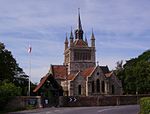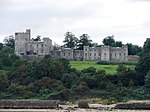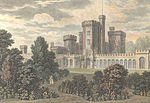Barton Manor
Country houses on the Isle of WightHouses completed in the 17th centuryManor houses in EnglandUse British English from June 2015

The history of Barton Manor (originally from the Old English, burc-tun; alternates: Burton, Burtone, Berton, Barton) spans over 900 years and was first mentioned in the Domesday Book of 1086. It is a Jacobean manor house in Whippingham, on the Isle of Wight. While it retains two 17th-century elevations, other frontages were renovated, as was the interior in the 19th century. Two medieval lancet windows originated at a former Augustinian priory. Barton is the most northerly of all the Island manor houses.
Excerpt from the Wikipedia article Barton Manor (License: CC BY-SA 3.0, Authors, Images).Barton Manor
Bartonwood Road,
Geographical coordinates (GPS) Address Nearby Places Show on map
Geographical coordinates (GPS)
| Latitude | Longitude |
|---|---|
| N 50.7474 ° | E -1.2643 ° |
Address
Bartonwood Road
PO32 6LA
England, United Kingdom
Open on Google Maps







